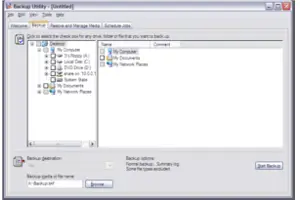BACKUP
In information technology, a backup, or the process of backing up, refers to the copying and archiving of computer data so it may be used to restore the original after a data loss event
The backup utility can be quickly accessed by typing the command “ntbackup”.

By default, the Backup Utility will use Wizard Mode. Uncheck the Always start in wizard mode checkbox.
Select Advanced Mode, which enables you to configure the backup exactly as you want it.
Select the Backup tab.
From the tree view, select the location of the backup.
Check the box next to the folder you wish to backup, e.g. Data. You can also backup an entire drive by selecting the checkbox next to the relevant drive letter.
Once you have selected all the files you wish to backup, you can save the selection by clicking Job.
And selecting Save Selections.
Choose a name for the backup selection and click Save.
You can now open the backup selection each time you perform a backup, rather than re-selecting all of the files.
Next, specify a location for the backup, e.g. A network share or removable hard disk.
Once a location has been specified, select the Start Backup button.
Because this is a new backup, you should select the Replace the data on the media with this backup radio button.
Select the Advanced Option.
The Disable volume shadow copy option allows the backup of locked and open files. If this option is selected, some files that are open or in use might be skipped.
You can choose the Backup type from the Backup Type drop-down list.
In this case, a Normal backup is required.
Click on OK once all options have been configured.
To begin the backup select Start Backup.
The backup will then begin.
Once completed, you can either view a Report or Close the Backup dialog box.
Notice that the Archive attribute on the files in the data folder have now been cleared.
The backup has been saved to the network share as “databackup.bkf”.
Performing a Differential Backup
In this scenario, a differential backup is performed the day after the normal backup.Because the current.txt file has been modified, the archive attribute is set.
Open the ntbackup utility and select Job.
Select Load Selections.
And open the backup selection saved previously.
Specify a new name for the backup file.
Select Start Backup.
Click the Advanced Button.
Select the Backup type drop-down list.
Select the Differential Option.
Click on OK once all options have been configured.
Click on Start Backup to begin the backup process.
Once the backup is complete, click on Close.
Notice that the archive bit on the modified file stays selected. The differential backup will only contain this file.
Performing an Incremental Backup
With an incremental backup, the archive bit will be cleared. In this example, two files in the folder have been modified since the normal backup.Again, using the ntbackup utility, open the backup selection, and begin the backup process.
This time, select the Incremental Backup type.
Once the backup has finished, click on Close.
Notice that, unlike a differential backup, the archive bit has now been cleared.
Creating a Backup Schedule
Incremental Backup Strategy
Monday – Normal Backup of entire computer
Tuesday – Incremental Backup of Data folder
Wednesday – Incremental Backup of Data folder
Thursday – Incremental Backup of Data folder
Friday – Incremental Backup of Data folder
The backup utility allows you to schedule backup jobs to run at pre-set times. In this example, every Monday a normal backup of the entire computer is performed. Every Tuesday, Wednesday, Thursday and Friday nights, an incremental backup of the data folder is performed.
Launch the ntbackup utility and select the Schedule Jobs tab.
Select the Add Job button.
Click on Next to continue.
Select which files you would like to backup, in this case Back up everything on this computer.
Once selected, click Next.
Choose a name and location for the backup and click Next.
Ensure Normal backup is selected and click Next.
Click on Next to continue.
Because this is a normal backup, data should not be appended to the end of an existing backup.
Select the Replace the existing backup radio button.
Click on Next to continue.
Choose a name for the Schedule and then select the Set Schedule button.
Using the Schedule options, a backup schedule for the job can be set.
In this example, a normal backup will be performed every Monday night.
Click on OK to continue.
The scheduled task will need to run with the permissions of a user with the relevant rights, e.g. A member of the Administrators or Backup Operators group. Click on OK to continue.
Click on Next to continue.
Click on Finish to close the wizard.
The normal backup job has now been created. Click on Add Job to create the incremental backup schedule.
Click on Next to continue.
Select which files you would like to backup, in this case Back up selected files, drives, or network data. Once selected, click Next.
Select the files to be backed up.
Click on Next to continue.
Click on Next to continue.
Select the Backup type drop-down list and select Incremental.
Click on Next to continue.
Click on Next to continue.
Because this is an incremental backup, it is often easier to append data to the end of an existing backup. Click on Next to continue.
N.B.
You should set the Tuesday backup to replace the existing backup .
Choose a name for the backup job and click Set Schedule.
Choose a schedule from the available options.
The backup will be performed at midnight every Tuesday, Wednesday, Thursday, and Friday.
Click on Next to continue.
Click on Next to continue.
Click on Finish to close the wizard.
The backup schedule has now been set.



